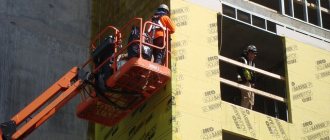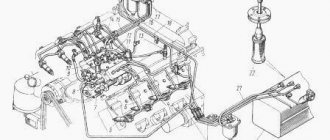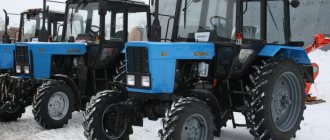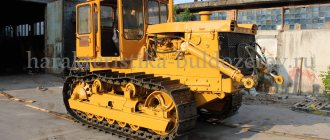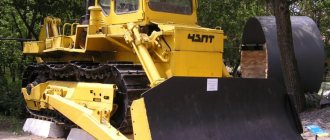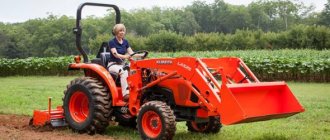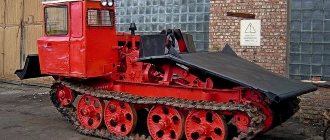Concept and features
The traction classes of agricultural machines are a key characteristic that indicates what maximum traction force the equipment is capable of developing. The traction force will depend not only on the factory characteristics, but also on the type of soil during operation. On clay and waterlogged soil, traction characteristics will be lower than on dry sandy soil. Therefore, factory specifications for all agricultural tractors are considered under the same operating conditions.
The classification of tractors according to the traction feature is carried out under soil conditions:
| Soil characteristics | Wheeled agricultural machine | ||
| 4x2 | 4x4 | On caterpillar | |
| Permissible slip | less than 16% | less than 14% | less than 3% |
| plantings | Stubble after planting spikelets | ||
| Permissible humidity | 25-35% | ||
| soil density | Medium | ||
The traction force of agricultural machinery is expressed in numbers in tons of effort force - tf. At the same time, the traction force can be expressed in kilonewtons - kN. The ratio of kilonewtons to ton force is as follows: 1 tf = 10 kN. So, a machine of 6 tf is 60 kN. The performance of the same machine on tracks and wheels during operation may differ, since the patency of the first is higher.
The procedure for labeling
The technical regulation TR CU 031/2012 allows you to label the products themselves, indicate the required information on a special plate and in operational documents. The list of mandatory information that must be indicated in the technical description of the tractor and trailers includes a list of the main characteristics of the product:
- dimensions and parameters of the self-propelled vehicle, trailer or its component;
- technical features of the chassis, control devices, seats, locking systems, other components and assemblies;
- description of the protection of all the main elements and systems of equipment;
- indicators of permissible loads and power, calculations of maximum speed;
- other data provided for by the technical regulations of the Customs Union 031/2012.
A technical description is drawn up for each independent piece of special equipment, trailer or component. If the transport already has a certificate or type approval issued under UN Regulations. You can fill out a technical description with a brief description of the characteristics.
The marking plate indicates not only a single mark of conformity, but also the following information:
- type, model, brand of the vehicle or other device;
- manufacturer's name, country of issue;
- Year of manufacture;
- numbers of the chassis, engine and other components, if they are provided in the technical, operational and registration documents.
The plate is attached in such a way that its contents can be read without the use of additional tools or disassembly of the product. All information should be easy to read, maintain proper form even when exposed to external factors.
Buyers of equipment have the right to familiarize themselves with the technical description and marking information for the goods. When deliveries and sales, all technical and operational documents must be transferred by the seller. Also, without these documents, it is impossible to obtain a permit for certification.
If you want to learn more about the certification and labeling of agricultural and forestry tractors, trailers, please contact our specialists. We will explain the requirements of the technical regulation of the Customs Union 031/2012, we will help to issue permits and accompanying documentation.
Main characteristics of agricultural machinery
All agricultural machines, from garden walk-behind tractors to large industrial models of agricultural machines, are divided into 17 groups according to traction. But the popular models of agricultural machines that are used in private households are divided into 8 groups. The first three groups relate to walk-behind tractors and mini-equipment. Recently, manufacturers have also begun to produce agricultural machines with 7 traction forces, previously equipment with this indicator belonged to large industrial ones. But due to the development of private farms, the class 7 tractor became in demand by farmers and it was transferred to a general purpose.
The main indicators of all models and the traction class of tractors are the table below:
| Traction Force | Equipment power in l. With. | Possible pulling forces, kN | Average weight of the car, kg | Popular models of equipment | |
| On wheels | On tracks | ||||
| 0,1 | — | — | — | Motoblock garden | — |
| 0,2 | 10–14 | 1,8–5,4 | Less than 5 30 | Productive motoblocks, mini-tractors. | — |
| 0,4 | — | — | — | Jinma (120, 264E), domestic ones are not produced today. | — |
| 0,6 | 22–25 | 5,4–8,1 | 1 500 | Belarus 300, T30 and T25. | — |
| 0,9 | 40–50 | 8,1–12,6 | 2 600 | T40 | — |
| 1,4 | 55–75 | 12,6-18 | 2 900 | YuMZ 6, Belarus 900, MTZ 80/82. | — |
| 2 | 75-90 | 18–27 | Less than 5,000 | Belarus 1220 | T 70, 54 (special) |
| 3 | 90 | 27–36 | 6 300 | Belarus 1500, T150k | T 150, DT 75. |
| 4 | 130–165 | 36–45 | Less than 7,900 | Belarus 2022 | T 4A, HTZ-201. |
| 5 | From 165 | 45–54 | 7 900 | Belarusian 3023, K 700. | T 501. |
| 6 | 300–400 | 54–63 | Less than 11,600 | John Deere 9430 | T 130m |
| 7 | 300–400 | 63–72 | Less than 11,600 | ATM Terrion 7360 | — |
The table shows the main indicators that are taken into account when choosing a model. The more difficult the work ahead and the more land, the higher the class of equipment will be needed.
Tractors traction class 0.2
Mini-tractors of traction class 0.2 (T-012, AMZhK-8, MTZ-082, MT-15, etc.) are designed to work in small-scale, selection fields and in farms. They can be combined with a plow, mower, cultivator, trailer and other implements and machines made especially for them.
A mini-tractor, or small-sized tractor, is a universal mobile power tool with a two-axle wheeled chassis or caterpillar drive.
Motoblock is a universal mobile power tool based on a single-axle chassis, controlled by a following operator using rod levers. Conventionally, the walk-behind tractor can be attributed to the traction class 0.1.
Types of agricultural technology
According to their technical characteristics, traction force and power, all agricultural machinery is divided into groups:
- 0.2; 0.4 - mini tractors. Small, low-power, suitable for working in a private courtyard, used with attachments and trailed equipment. They are used in agricultural complexes, for garden and road works. Compact and lightweight, they easily pass through the narrow streets of cities.
- 0.6; 0.9; 1.4; 2 - universal machines. Used for agricultural and road works. They are used on row crops, when planting and harvesting, preparing the soil. This type may include a subgroup of universal tillers. Used to prepare areas for planting, for cultivation.
- Tractor class 3; 4; 5; 6; 7 - general purpose machines. Suitable for any energy-intensive road and agricultural work. In agriculture, they are used in large agricultural complexes.
- A separate group with different traction capabilities is specialized agricultural machines used for specific crops, for example: for harvesting and planting root crops, sunflowers, etc.
- Equipment with a self-propelled chassis is a narrow line, has a low traction force. For example, the most popular self-propelled tractor T 16.
We will consider the most popular types with different traction classes in more detail.
Miniature helpers of farmers
Equipment 0.2 tf is miniature, but in demand in private households. These include powerful walk-behind tractors and mini-tractors. Suitable for cleaning narrow streets, in the private sector with its help you can perform almost any street work. The average price on the market, depending on the manufacturer and capacity, from 85 00 rubles.
Among the popular ones, the following stand out: Belarusian 112; 08K; 132N and MTZ 082, Uralsky T0.2, KMZ 012. Less adapted, Chinese agricultural machines are also in demand by farmers: Jinma 100 and 200x; Chery FD 15; Dofgan 244; Hintai-220; Photon TE 244.
Cheap and cheerful
Tractor classes 0.6 and 0.9 are common among private farms. This is a more powerful agricultural machine used for various types of agricultural work on plots from 50 acres. Two popular models of class 0.6 are produced at the Vladimirsky TZ - T 30 and 25A. Interesting equipment with a self-propelled chassis T 16. Of the modern ones, Belarus 310.3 20, 321 and VTZ 2032 stand out. Powerful agricultural vehicles with good cross-country ability and a large number of attachments and trailers.
Traction class 0.9 is represented by modern LTZ 55 (produced since the 90s at the Lipetsk Tractor Plant) and VTZ 45 from Vladimirsky TZ. Of those tested over the years, T 40 and 40A stand out. The average price on the market is from 170 thousand rubles.
practical and popular
Among the most practical and popular among farmers, agricultural machines of the 1.4 tf class stand out. They cope with work better than mini-types, since the power is suitable for performing any type of work in the fields and on the roads. Tractors of this class are popular in the construction industry, as the price is much lower than powerful production models.
Among the brightest representatives of 1.4 ts, the MTZ 80 and 82 tractors (manufactured by the Minsk Tractor Plant), Belarus 900 stand out. MTZ 80 has been produced since the late 80s and has proven itself only on the positive side. Suitable for working on all types of soil and used in various weather conditions. The average price is from 360 thousand rubles.
Powerful wagons
The traction tractor of class 2 tf is interesting for various types of work. Until the 80s, class 2 agricultural machines were produced only on tracks. Among these are known: T 70 and 54V. LTZ 155 is considered to be a wheeled class 2 of the early ones. It is used for construction, road and agricultural work. High-performance with high technical characteristics. Among the latter stand out: Belarus 1221 and improved 1222, John Deere 6020, 6130D made in the USA. The price starts from 270 thousand rubles. Imported ones cost from 450 thousand rubles. But not always imported tractors are adapted to our weather conditions.
Topic 4 Technology of work during the maintenance of tractors
Plan:
4.1 Significance, types and scope of work on the maintenance of tractors.
4.2 Technical means for performing tractor maintenance work.
4.3 Features of the technology of maintenance of energy-saturated tractors at the repair and maintenance enterprises of the district level.
4.1 Significance, types and composition of tractor maintenance work
Among the main and most cost-effective measures to keep machines in good condition during their use and storage is maintenance (TO). This is confirmed by the experience of a number of farms in our republic in 1970–1980, where high-quality maintenance was organized. The cost of overhaul as a result of this was reduced by three times in relation to the all-Union level. Maintenance specialists claim that compliance with maintenance rules reduces the number of tractor failures by 2–3 times, saves oil products by 8–12% and reduces the consumption of spare parts by 30% and increases their service life by 2–2.5 times. It is known from practice that with an increase in the oil change period by 50%, the engine resource is reduced by more than 5–10%. Mixing different types of oil and replacing them leads to the same consequences.
Maintenance is a set of works to reduce the wear of parts, prevent malfunctions, as well as identify them in order to timely eliminate and maintain the performance of the product.
Types of maintenance and conditions for their implementation are presented in table. 1.1. The frequency of maintenance is given in hours, sometimes in order to simplify the planning and management of maintenance, the frequency for tractors is indicated in liters of fuel consumed, physical ha or conventional reference ha.
Break-in maintenance (TO-0) is performed for new or overhauled machines, as well as when a new or overhauled unit is installed on the machine, especially the engine. The goal is to complete the running-in of rubbing surfaces and prepare them for full load operation. It is known that the running-in is mainly completed for engines after 50–60 engine hours, and for transmission units after 85–100 engine hours.
Table 1.1
Periodicity and conditions for maintenance of tractors
| Types of maintenance | Frequency of maintenance, conditions for carrying out |
| During operational run-in (TO-0) | Preparing, conducting and completing work |
| Every shift (ETO) | 8–10 hours |
| First (TO-1) | 125 moto-hours |
| Second (TO-2) | 500 moto-hours |
| Third (TO-3) | 1000 moto-hours |
| Seasonal during the transition to the spring-summer period (STO-L) | At a steady average tair> + 5 ºС |
| Seasonal during the transition to the autumn-winter period (STO-Z) | At a steady average tair < + 5 ºС |
| Under special operating conditions | When operating the tractor: — on sandy soils; - at prolonged low and elevated temperatures; - on stony soils; - on swampy soils. |
| In preparation for short-term storage | Between work periods |
| In preparation for long term storage | Not later than 10 days from the end of the period of use |
| During long-term storage | Once a month when stored outdoors and under a canopy; once every 2 months when stored indoors |
| When removed from long-term storage | 15 days prior to use |
Warranty obligations after periodic maintenance for the tractor and its components must be 80% of the term until the same type of maintenance.
Maintenance includes: depreservation of the machine, preparation for operation of batteries, checking oil and lubricant levels, adjusting the tension of belts, track chains, tire pressure, refueling the cooling system and fuel. Check and, if necessary, tighten the external threaded connections. They listen to the operation of the engine, control the operation of the steering, brake system, main clutch and instrument readings.
The machine must be used during this period for light work, such as transport. In the process of work, they monitor the condition of all mechanisms, control the absence of leaks, the tone of noise, excessive heating, and the correct functioning of the main mechanisms.
At the end of the break-in, the clearances in the engine valves, clutch, control mechanism and brakes are adjusted. Tighten the fastening of the cylinder heads and other assembly units. They clean the centrifugal oil cleaner, wash the filters, change the oil in the diesel engine and its components, power transmission (in the absence of an oil filter) and lubricate the mechanisms.
ETO is carried out at the end or at the end of the shift and includes the following work: cleaning, wiping, if necessary, washing, inspection, tightening, eliminating leaks, checking the level of oil, coolant. Refueling, engine, steering, brakes, lighting and alarm systems are monitored. ETO uses the tool supplied with the machine.
The scope of work performed during TO-1 after 125 motor-hours:
1) inspection, cleaning and washing of the tractor;
2) checking and, if necessary, adjusting the tension of the drive belts, tire pressure, track tension;
3) maintenance of the air cleaner (washing the cassettes and deflector, changing the oil);
4) draining sludge from tanks and filters for coarse fuel cleaning, oil from the brake compartments of the rear axle and torque booster, condensates from air cylinders;
5) battery maintenance;
6) adding oil and lubricating the main parts of the tractor;
7) checking the condition of the external fasteners of the components, their operability and serviceability at idle and under load, the tightness of the connection between the air cleaner and the inlet pipeline, the operation of the centrifugal oil cleaner.
Work at TO-2 after 500 moto-hours. begin with the execution of TO-1 operations, and with TO-3 operations from TO-1 and TO-2 operations. All other works that are provided by the technology for TO-2 and TO-3 are called additional. Their TO-2 list includes:
1. Check and, if necessary, adjust:
- injectors on the pressure of the start of injection and the quality of the fuel spray;
- clearance between valves and rocker arms;
— clutches of the main engine;
- mechanism for switching on the power take-off shaft;
— tormozka cardan transmission;
— brakes and their drives;
- steering and control mechanisms for turning tracked vehicles.
2. Cleaning the rotor of the centrifugal oil cleaner, changing the oil in the engine crankcase with flushing the lubrication system and other components according to the lubrication table.
3. Elimination of detected faults.
For additional work at TO-3 after 1000 motor-hours. relate:
§ assessment of the technical condition of the tractor and its components;
§ replacement of oil in the engine crankcase and other components with flushing of systems, crankcases, housings, filters, fuel tanks, fuel fine filter elements;
§ tightening the fastening of the cylinder head of the main engine;
§ cleaning, adjustment and tuning of the fuel pump and injectors removed from the engine with checking the fuel supply advance angle;
§ removal, disassembly and repair of the generator, starter;
§ adjustment of bearings of guide and drive wheels, final drives, support and support rollers, convergence of front wheels;
§ checking the state of the relay-regulator, adjusting and inspecting the wiring with insulation of damaged areas.
Seasonal maintenance during the transition to the autumn-winter period includes:
Ø filling the cooling system with antifreeze;
Ø checking the operation of the thermometer, thermostat and blinds;
Ø replacement of oil and grease in the engine crankcase and other components with flushing of the lubrication system and crankcases;
Ø flushing of tanks, settling tanks of the diesel power system and the starting engine;
Ø replacement of filter elements of the fuel fine filter;
Ø bringing the density of the electrolyte in the battery into line with the period of operation;
Ø adjustment of the relay-regulator in accordance with the period of operation;
Ø fixing or removing the engine insulation cover, cabin insulation.
From the above lists of work on maintenance of tractors, the following technological operations can be distinguished:
- washing and cleaning;
- control and testing;
- adjusting.
Traction class 6 tractors
Traction class 6 tractors are designed for reclamation, road, planting and other work, as well as plowing. This class includes the T-130 caterpillar tractor with a four-cylinder diesel engine with a capacity of 117.8 kW (160 hp). Track width 1880 mm; ground clearance 407 mm; forward speed 3.63…12.45 km/h, backward 3.53…9.9 km/h.
Tags: Tractor
Next Car classification
All entries
Back Classification of tractors and their types
